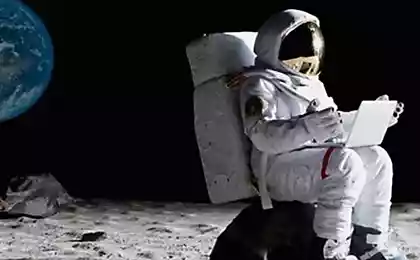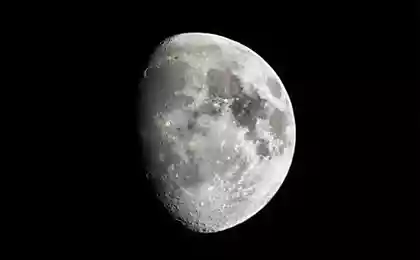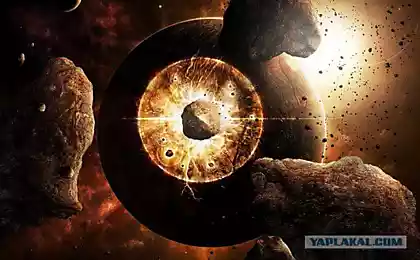953
Some facts about the cosmos

1. red giant - a star Betelgeuse has a diameter larger than the orbit of the Earth around the sun.
2. 19% of the solar energy absorbed by the atmosphere, 47% - falls to the ground, and 34% - back into space.
3. The duration of a total solar eclipse is less than 7, 5 minutes; total lunar eclipse - 104 minutes.
4. If the Earth rotates in the opposite direction around its axis, the year would be less than two days.
5. The first star catalog was compiled Hipparchus in 150 BC
6. 99 percent of the mass of the solar system is concentrated in the sun.
7. About forty new stars appear in our galaxy every year.
8. The height of the volcano Knicks Marseille, located on Mars - more than 20 km.
9. When we look at the most distant of the visible stars, we look at four billion years in the past. The light from her, traveling at a speed of almost 300 000 km / s up to us only after many years.
10. Within 10 minutes the spacecraft can take photos of up to 1 million square feet. km earth surface, whereas with a plane surface removed for 4 years, and geography and geology would be required to not less than 80 years.
11. The only married couple to fly into space - US astronauts Jan Davis and Mark Lee were part of the crew of the shuttle "Endeavour" (12-20 September 1992).
12. car, dvuzhuschemusya an average speed of 60 miles per hour, it would take about 48 million years to reach the nearest star (after the Sun), Proxima Centauri.
13. 12 billion years - this is the age of the oldest galaxies photographed space telescope "Hubble».
14. Over the past 500 years, the mass of the Earth has increased by one billion tonnes by space matter.
15. Southern Cross - the smallest constellation in the sky, but it has the largest concentration of bright stars.
16. The nearest (after the sun) our star (Proxima Centauri) - 4, 24 light-years.
17. The smallest planet in the solar system - Pluto, the largest - Jupiter.
18. All the planets of the solar system could fit inside Jupiter.
19. The pressure in the center of the Earth in the three million times higher than the pressure in the atmosphere.
20. The duration of the first spacewalk (Leonov) was 12 seconds.
21. In one minute, the sun produces more energy than it consumes the whole earth for a year.
22. During the lifetime of the station "Mir" on it was visited by 135 people from 11 countries.
23. On board the space station "Mir" is more than 14 tons of various research equipment.
24. The total mass of the station "Mir" with two docked korablinmi more than 36 tons.
25. The duration of one "year" on this planet Pluto - 247, 7 terrestrial years.
26. The first space flight of Yuri Gagarin lasted exactly 1 hour 48 minutes.
27. 2, 5 km - maximum thickness of the ice at the north pole of Mars.
28. The space station "Mir" was launched into orbit on Feb. 20, 1986.
29. Asteroids 4147, 4148, 4149 and 4150 are named after "The Beatles" John Lennon, Paul McCartney, George Harrison and Ringo Starr, respectively.
30. If you fill a teaspoon of the substance that makes up a neutron star, its weight will be about 110 million tons!
31. The largest lunar crater, seen from Earth, called Bailey or "field of death." It has an area of about 26,000 square miles.
32. The first black man into space was a melted Guyon Blufo Junior, who was a member of the third crew of flight "Chellindzhera" (30 August 1983).
33. Land - the only planet not named after a god.
34. The first map of the Moon was made in 1609 by Thomas Harriot.
35. Carolyn Schumacher discovered 32 comets and more than 800 asteroids.
36. The highest temperature on the Moon - 117 degrees Celsius.
37. The atmosphere of Mars is 95% carbon dioxide.
38. The lowest temperature on the moon -164 degrees Celsius.
39. The first observatory was built in South Korea.
40. The highest mountain on the Moon has a height of 11 500 m.
41. The hottest planet of our Universe - Venus.
42. The world's largest planetarium is located in Moscow.
43. Mountains on Mars reach a height of 20-25 kilometers.
44. The planet Uranus is visible from Earth with the naked eye.
45. Of the twelve brightest stars, Capella - the northernmost.
46. The night temperature on the moon reaches -150 degrees Celsius.
47. Every day the Earth falls about 200 thousand meteorites.
48. To the sunlight reached the Earth requires about 8, 5 minutes.
49. If the web of stretch to the nearest star in the constellation Centaurus, it would weigh five hundred thousand tons.
50. About 27 tons of space dust falls to Earth every day. During the year more than 10 000 tons of dust lands on Earth.
51. The area of the solar surface the size of a postage stamp shines with the same energy as 1 500 000 candles.
52. Astronomers believe that the universe every atom of matter accounts for about 400 liters of space.
53. Neutron stars are the strongest magnets in the universe. The magnetic field of a neutron star is a million million times larger than the Earth's magnetic field.
54. Ganymede, the largest satellite of the planet Jupiter in size exceeds the planet Mercury. The diameter of Ganymede is about 5269 kilometers.
55. The Day of the planet Mercury twice as long as a year. Mercury rotates on its axis very slowly, and one revolution around the sun takes a little less than 88 days.
56. Total launches satellites into space, only one of which was destroyed by a meteorite got in (the satellite of the European Space Agency «Olympus» in 1993).
57. The diameter of the Moon - 3476 kilometers.
58. Venus day is longer than a year.
59. The Earth weighs about 600 trillion tons.
60. Moon easier Earth 80 times.
























